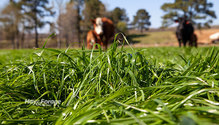
As temperatures warm and forage grasses break dormancy, an adjustment to supplemental mineral intake by grazing cattle is often required to prevent a magnesium deficiency in the blood. Low blood magnesium in an animal is responsible for a condition called grass tetany, which is also known as grass staggers.
“Grass tetany typically occurs in the spring, but it can occur in the fall or when you have rapidly growing, succulent, cool-season grasses,” explains Ted Wiseman who is an extension educator in Perry County, Ohio. “Lush green grasses are generally low in magnesium, but the condition is made worse by having high potassium and protein levels.”
The extension educator notes that mineral imbalances of high soil potassium and nitrogen, coupled with low calcium, sodium, and phosphorus levels, can tie up magnesium in the soil, which exacerbates the problem.
Feeding a high-magnesium mineral supplement can help reduce or prevent grass tetany problems. According to Wiseman, cows require 20 grams of magnesium daily, which can be accomplished through consuming 3 to 4 ounces per day of a mineral mix containing 12% to 15% magnesium.
“You need to monitor mineral intake and make sure all animals are consuming desired amounts,” Wiseman writes. “Magnesium alone is not palatable and will lower consumption. If livestock do not consume adequate levels from a free-choice mineral mix, combine the supplemental magnesium with more palatable feeds such as dried molasses or soybean meal. Adding salt may help boost mineral intake and also ensure the sodium requirement is being met.”
Start early
Provide the high-magnesium mineral supplements 15 to 30 days prior to the time livestock are turned out onto lush pastures. The high-magnesium supplement does not need to be provided year-round, but it won’t create any problems if it’s fed too early or too late into the season.
Older, lactating cows are more prone to suffering from grass tetany. Steers, heifers, dry cows, and growing calves are less susceptible, but they can still contract tetany under the right conditions.
Symptoms of grass tetany often include going off feed, nervousness, muscle spasms, convulsions, irritability, and aggressiveness. Severe cases may result in a comatose state or death.
Wiseman encourages producers to keep a close eye on livestock in the early grazing season since grass tetany symptoms often occur rapidly. If grass tetany is suspected, contact your veterinarian immediately.

